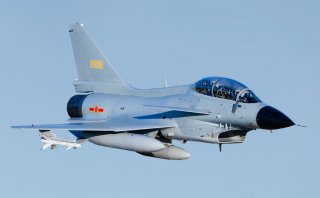Why Does China's Air Force Keep Coming So Close to Taiwan?
“We warn those ‘Taiwan independence’ elements: those who play with fire will burn themselves,” Chinese Defence Ministry spokesman Wu Qian said in January.
Taiwan’s Defense Ministry has reported a new incursion by China’s Air Force, the latest in Beijing’s increasingly bold pattern of encroachment into Taiwanese airspace.
Taiwanese officials stated on Monday that four J-16 and four J-10 multirole fighter jets, a Y-8 anti-submarine aircraft, and a KJ-500 early warning and control plane entered Taiwan's air defense identification zone (ADIZ). The Y-8 reportedly flew through the Bashi Channel connecting the Pacific to the South China Sea, while the others traveled in airspace southwest of Taiwan.
Taiwan scrambled planes to warn the Chinese aircraft away, according to the defense ministry. This incident is the latest in a procession of increasingly ambitious Chinese incursions. In late March, Taiwan reported the largest ever Chinese foray into its ADIZ—the defense ministry identified as many as twenty Chinese aircraft, including four nuclear-capable H-6K bombers and ten J-16 fighter jets. A “person familiar with Taiwan’s security planning” told Reuters that the flights were part of an exercise to “simulate an operation” against U.S. warships sailing through the Bashi channel. Other experts have identified a more alarming military context, noting that the Chinese aircraft appeared to be practicing a wide bomber encirclement of Taiwan. In the event of a major conventional conflict, this maneuver could be part of a larger effort to suppress Taiwan’s air and coastal defenses as a prelude to a possible Chinese invasion of the island.
A Taipei-based think tank noted earlier that China’s People’s Liberation Army (PLA) aircraft made a record 380 incursions into Taiwan’s ADIZ in 2020.
Frequent aerial incursions are but one part of Beijing’s broader effort to signal its sovereignty over Taiwan through military muscle. Earlier this week, China’s People’s Liberation Army Navy issued a statement announcing that a Chinese carrier strike group (CSG), led by the Liaoning aircraft carrier, conducted “routine” drills in the waters near Taiwan, with the stated goal of enhancing “its capability to safeguard national sovereignty, safety and development interests.” The Chinese state media outlet Global Times provided a more pointed description, writing that the exercises were aimed at “comprehensively boosting its combat capability and against Taiwan secessionists rather than any specific country.”
Liaoning was accompanied by five other vessels, including the Type 052D guided-missile destroyers Chengdu and Taiyuan, the flagship Type 055 destroyer Nanchang, Type 054A frigate Huanggang, and a supply ship. Offering a substantial weapons payload improvement over the previous Type 052D class, the Type 055 line will further boost the combat capabilities of Chinese CSG’s. The navy added, without elaborating, that "similar exercises will be conducted on a regular basis in the future.”
China’s military and foreign policy apparatus has been increasingly less demure about Beijing’s territorial claim on Taiwan. Chinese leader Deng Xiaoping famously proclaimed that the People’s Republic of China can wait one hundred years to reunify with Taiwan if necessary. Under the leadership of Xi Jinping, that timeframe seems to have been considerably shortened. Along with unrelenting military pressure, Chinese officials and state media have steadily sharpened their rhetoric against the sovereign island. “We warn those ‘Taiwan independence’ elements: those who play with fire will burn themselves,” Chinese Defence Ministry spokesman Wu Qian said in January. “Taiwan ‘independence’ means war,” he added.
Mark Episkopos is a national security reporter for the National Interest.
Image: Reuters

